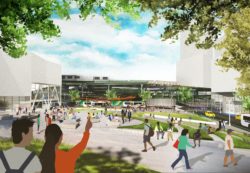
Image Credit: NYCEDC and WXY Architecture & Urban Design
The Vision Document represents the first effort by the City and the Brooklyn community to solely focus on Broadway Junction. On August 15, 2019, Council Member Rafael L. Espinal, Brooklyn Borough President Eric L. Adams, and the New York City Economic Development Corporation (NYCEDC) commissioned a Vision Document, Broadway Junction: Vision for the Future that serves as a guide to supporting the transformation of Broadway Junction in Brooklyn. The Vision Document is the first step towards transforming and reinvigorating the area’s transit hub and economic center.
The document and the plan to revitalize Broadway Junction comes from a need to create accessibility for the area. Despite being Brooklyn’s third busiest station, the four-level Broadway Junction station currently lacks accessibility, basic services, and amenities. The area is dominated by vacant sites, parking lots that unpleasant and unsafe pedestrian conditions, poor lighting, and confusing streets.
The Vision Document is part of the City’s commitment to study the Broadway Junction area as part of the 2016 East New York Neighborhood Plan. The document was the result of the community leadership and efforts of the
Broadway Junction Working Group. The working group, formed and chaired by Council Member Espinal and Borough President Adams, comprised of community leaders such as local community boards and various interest groups in Eastern Brooklyn. The group met six times over the course of a year, conducted a commuter intercept and community survey, and hosted an open house to collect ideas from the public.
The Vision Document identifies community priorities and recommendations for the Broadway Junction area. The document outlines five pillars to ensure comprehensive, inclusive growth in the Broadway Junction area. The pillars include “transit equity and growth,” “inclusive growth,” “economic and workforce development,” “active places and neighborhood amenities,” and “public realm and open space.” The five pillars would be used to guide future investments in the area such as creating accessibility to the transit hub and adding new retail and attractions to serve transit riders, and provide employment and training opportunities for the East Brooklyn community.
Broadway Junction is one of Brooklyn’s major transit hubs and occupies approximately 25 acres in Eastern Brooklyn. It is the location of five subway lines (A,C, J, L, Z), six bus routes, and the Long Island Railroad and the meeting point of the residential neighborhoods of Bedford-Stuyvesant, Brownsville, Bushwick, Cypress Hills, East New York, and Ocean Hill. The East New York Industrial Business Zone, home to over 100 local industrial businesses, is also located to the south of the Broadway Junction area. Broadway Junction is connected to the city’s various transit and employment hubs such as Lower Manhattan, Midtown, Downtown Brooklyn, Jamaica, and Long Island City.
For the next step, NYCEDC, city officials and agencies are working to develop a strategy to implement this vision and will continue to seek feedback from residents, workers, business owners, and commuters to help shape Broadway Junction’s future.
The Broadway Junction Vision Document builds on approximately $267 million of funding dedicated to the surrounding communities of East New York, Cypress Hills, and Ocean Hill. Other projects and investments in the communities include: the renovation of Callahan Kelly Playground and Park, the reconstruction of Atlantic Avenue, the renovation and creation of a new community center at 121 Pennsylvania Avenue, streetscape improvements and gut renovation of an industrial asset in the East New York Industrial Business Zone, and new broadband to the East New York Industrial Business Zone and residential communities.
NYCEDC President and CEO James Patchett stated, “As one of our city’s major transit hubs, Broadway Junction has the potential to be a thriving economic engine for the community. This vision provides a blueprint to improve the station’s accessibility, enhance local amenities, revitalize public spaces and foster inclusive growth in the surrounding neighborhoods.”
Council Member Rafael L. Espinal stated, “Broadway Junction is an area that has been overutilized and underinvested in for decades. Through the East New York Neighborhood Plan, I made clear to the Administration that we must better study the area to identify potential investments and ways to deliver the quality jobs, services, and public spaces our community deserves. The community-driven process memorialized in this document lays a critical foundation for the City to make the necessary investments to realize this vision.”
Borough President Eric L. Adams stated, “Decades of advocacy have underscored the need for investment at Broadway Junction, but it was only after Council Member Espinal and my office directed the City to study the area’s potential as a critical transit and employment center for Brooklyn that we’ve been able to coalesce around a clear vision.”
By: May Vutrapongvatana (May is the CityLaw Fellow and New York Law School Graduate, Class of 2019).

